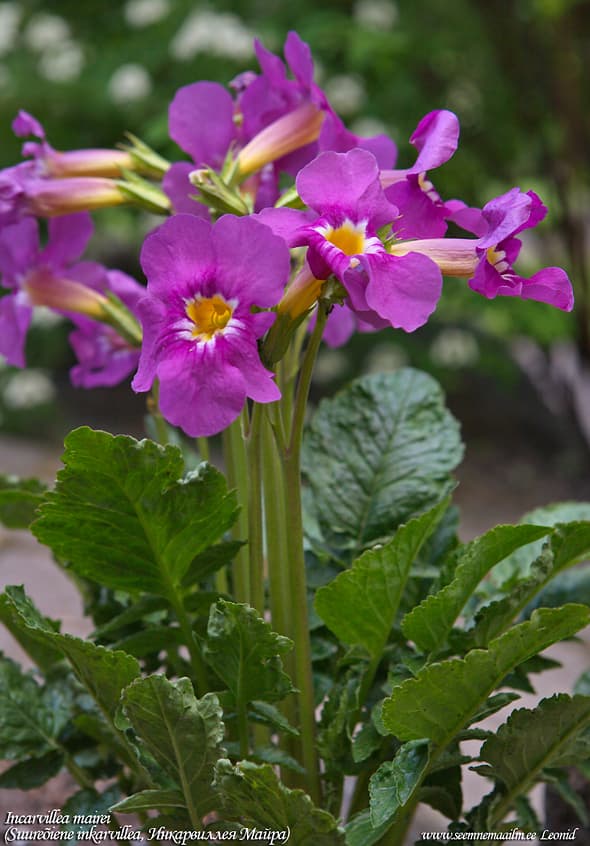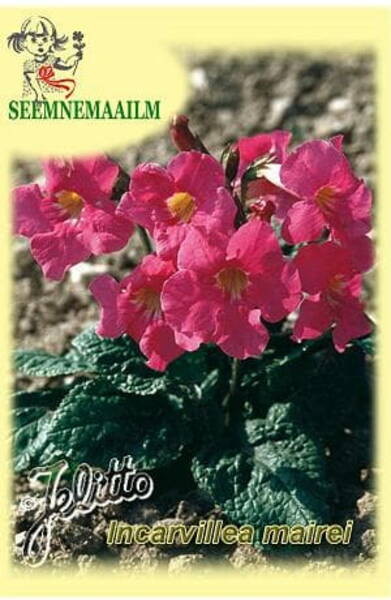Your shopping cart is empty!
Hardy Gloxinia
Incarvillea mairei (grandiflora var. brevipes)
1.79€
Ex Tax: 1.45€
Ex Tax: 1.45€
Hardy gloxinia - Incarvillea mairei (grandiflora var. brevipes).
Homeland: Northwestern China.
It blooms very impressively in May-June.
The height of the flowering plant is 40 cm.
The leaves are only basal, long-petiolate, lyre-shaped, weakly pinnately dissected, with rounded lobes up to 30 cm long.
Plants of this species produce large purple-red flowers, in which the inner yellow part of the corollas is covered with white spots.
Quite winter-hardy (Z3-Z8).
1.0 g = 280 seeds.
Location: light-loving, but tolerate some shade. It can remain in one place for up to 5 years.
Soil: grows well in light, fertile soils.
Care: it is frost-resistant, although it needs mulching with organic material before winter and good drainage.
In the spring, the protective material is removed, since the tubers can rot (and in snowless winters they can freeze). Annual mulching is recommended.
Reproduction: by cuttings and seeds, which are sown in March in a greenhouse.
Seeds are sown to a depth of 1 cm. Shoots appear 5 days after sowing. The optimal temperature for germination is +18+20 °C. Seedlings dive. In July, they are planted in the ground, deepening the root collar by 3-5 cm. They are shaded and watered daily.
Can be sown in April-July in open ground. At a temperature of +15 °C, seedlings appear 12-14 days after sowing. Seedlings bloom in the second year after sowing. In June - July they can be propagated by leaf cuttings. Winter storage of roots in a dry substrate at +3+8 °C is possible.
Use: for group plantings along paths, in rocky areas, where they combine well with Iberis and violets. They look impressive in bouquets, but do not last long.
Homeland: Northwestern China.
It blooms very impressively in May-June.
The height of the flowering plant is 40 cm.
The leaves are only basal, long-petiolate, lyre-shaped, weakly pinnately dissected, with rounded lobes up to 30 cm long.
Plants of this species produce large purple-red flowers, in which the inner yellow part of the corollas is covered with white spots.
Quite winter-hardy (Z3-Z8).
1.0 g = 280 seeds.
Location: light-loving, but tolerate some shade. It can remain in one place for up to 5 years.
Soil: grows well in light, fertile soils.
Care: it is frost-resistant, although it needs mulching with organic material before winter and good drainage.
In the spring, the protective material is removed, since the tubers can rot (and in snowless winters they can freeze). Annual mulching is recommended.
Reproduction: by cuttings and seeds, which are sown in March in a greenhouse.
Seeds are sown to a depth of 1 cm. Shoots appear 5 days after sowing. The optimal temperature for germination is +18+20 °C. Seedlings dive. In July, they are planted in the ground, deepening the root collar by 3-5 cm. They are shaded and watered daily.
Can be sown in April-July in open ground. At a temperature of +15 °C, seedlings appear 12-14 days after sowing. Seedlings bloom in the second year after sowing. In June - July they can be propagated by leaf cuttings. Winter storage of roots in a dry substrate at +3+8 °C is possible.
Use: for group plantings along paths, in rocky areas, where they combine well with Iberis and violets. They look impressive in bouquets, but do not last long.

Garden gloxinia. Bot. syn.: Incarvillea grandiflora var. brevipes.













